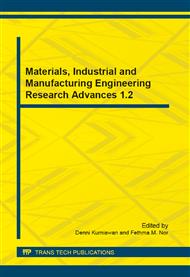[1]
Linden, D., Long Term Operating Experience with Corrosion Control in Industrial Axial Flow Compressors.
Google Scholar
[2]
Zhang, Y., et al., Passivity breakdown on AISI Type 403 stainless steel in chloride-containing borate buffer solution. Corrosion science, 2006. 48(11): pp.3812-3823.
DOI: 10.1016/j.corsci.2006.01.009
Google Scholar
[3]
Zhou, S. and A. Turnbull, Overview Steam turbines: Part 1–Operating conditions and impurities in condensates, liquid films and deposits. Corrosion Eng Sci Technol, 2003. 38(2): pp.97-111.
DOI: 10.1179/147842203767789177
Google Scholar
[4]
Jonas, O. and J.M. Mancini, Steam turbine problems and their field monitoring. Materials performance, 2001. 40(3): pp.48-53.
Google Scholar
[5]
Horner, D., et al., Novel images of the evolution of stress corrosion cracks from corrosion pits. Corrosion Science, 2011. 53(11): pp.3466-3485.
DOI: 10.1016/j.corsci.2011.05.050
Google Scholar
[6]
Nakai, T., et al., Effect of pitting corrosion on local strength of hold frames of bulk carriers (1st report). Marine structures, 2004. 17(5): pp.403-432.
DOI: 10.1016/j.marstruc.2004.10.001
Google Scholar
[7]
Yoshino, Y. and A. Ikegaya, Pitting and Stress Cracking of 12Cr-Ni-Mo Martensitic Stainless Steels in Chloride and Sulfide Environments. Corrosion, 1985. 41(2): pp.105-113.
DOI: 10.5006/1.3581971
Google Scholar
[8]
Cerit, M., Numerical investigation on torsional stress concentration factor at the semi elliptical corrosion pit. Corrosion Science, (2012).
DOI: 10.1016/j.corsci.2012.10.028
Google Scholar
[9]
Mu, Z.T., et al., The Stress Concentration Factor of Different Corrosion Pits Shape. Advanced Materials Research, 2011. 152: pp.1115-1119.
DOI: 10.4028/www.scientific.net/amr.152-153.1115
Google Scholar
[10]
Turnbull, A., L. Wright, L. Crocker, New insight into the pit-to-crack transition from finite element analysis of the stress and strain distribution around a corrosion pit. Corrosion Science, 2010. 52(4): pp.1492-1498.
DOI: 10.1016/j.corsci.2009.12.004
Google Scholar
[11]
Vignal, V., et al., Influence of elastic deformation on initiation of pits on duplex stainless steels. Electrochemical and solid-state letters, 2004. 7(4): p. C39-C42.
DOI: 10.1149/1.1647995
Google Scholar
[12]
Gutman, E.M., Mechanochemistry of materials. 1998: Cambridge Int Science Publishing.
Google Scholar
[13]
Huang, Y., et al., Ultimate strength assessment of hull structural plate with pitting corrosion damnification under biaxial compression. Ocean Engineering, 2010. 37(17): pp.1503-1512.
DOI: 10.1016/j.oceaneng.2010.08.001
Google Scholar
[14]
Paik, J.K., J.M. Lee, and M.J. Ko, Ultimate shear strength of plate elements with pit corrosion wastage. Thin-Walled Structures, 2004. 42(8): pp.1161-1176.
DOI: 10.1016/j.tws.2004.03.024
Google Scholar
[15]
Oltra, R. and V. Vignal, Recent advances in local probe techniques in corrosion research–analysis of the role of stress on pitting sensitivity. Corrosion science, 2007. 49(1): pp.158-165.
DOI: 10.1016/j.corsci.2006.05.032
Google Scholar
[16]
Tousek, J., Theoretical aspects of the localized corrosion of metals. (1985).
Google Scholar
[17]
Rajasankar, J. and N.R. Iyer, A probability-based model for growth of corrosion pits in aluminium alloys. Engineering fracture mechanics, 2006. 73(5): pp.553-570.
DOI: 10.1016/j.engfracmech.2005.10.001
Google Scholar
[18]
Campbell, F.C., Fatigue and Fracture: Understanding the Basics. 2012: ASM International.
Google Scholar
[19]
Marcus, P., Corrosion mechanisms in theory and practice. 2011: CRC Press.
Google Scholar
[20]
Shreir, L.L., Corrosion. Vol. I. Metal/environment reactions. 1976: Butterworth & Co. Ltd.
Google Scholar
[21]
Strehblow, H. -H. and P. Marcus, Mechanisms of pitting corrosion. Corrosion mechanisms in theory and practice, 1995: pp.201-238.
Google Scholar
[22]
Burstein, G., et al., Origins of pitting corrosion. Corrosion Eng Sci Technol, 2004. 39(1): pp.25-30.
Google Scholar
[23]
Melchers, R.E., Representation of uncertainty in maximum depth of marine corrosion pits. Structural safety, 2005. 27(4): pp.322-334.
DOI: 10.1016/j.strusafe.2005.02.002
Google Scholar
[24]
Corengia, P., et al., Microstructure and corrosion behaviour of DC-pulsed plasma nitrided AISI 410 martensitic stainless steel. Surface and Coatings Technology, 2004. 187(1): pp.63-69.
DOI: 10.1016/j.surfcoat.2004.01.031
Google Scholar


